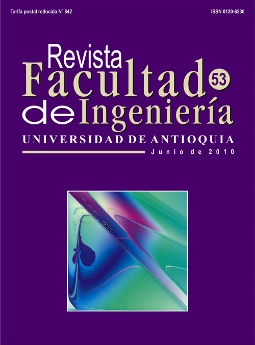Integrated production and distribution planning for an industrial conglomerate
Keywords:
linear Programming, supply chain optimization, steel industryAbstract
This paper presents the mathematical modelling of the supply chain of a cluster. This is the association of companies that take a common structure, for the semi-integrated steel industry as a tool for supporting decision looking at minimizing logistics costs of production and distribution of intermediate and final products of this industry. The mathematical model includes: raw material suppliers, manufacturing plants, distribution centers, local sales and imports. The costs associated, are the raw material, transportation and inventory, distribution and administrative expenses. The restrictions that are considered in the model are: the capacity of suppliers and manufacturing plants, satisfaction of demand, balance equations and restrictions on system configuration. The model was validated in a Colombian company presenting satisfactory results. The search for the optimal strategy was established with the support of the Software General Algebraic Modeling System - GAMS with the solver CPLEX ®.
Downloads
References
M. Goetschalckx, C. J. Vidal, K. Dogan. “Modeling and Design of Global Logistic System: A Review of Integrated Strategic and Tactical Models and Design Algorithms”. European Journal of Operational Research. Vol. 143. 2002. pp.1-18.
J. Velásquez. Optimización de la cadena de suministro en la industria de bebidas. Congreso de Ingeniería de Producción. Medellín. Octubre 4-6. 2001. Universidad EAFIT. 2001. pp. 25-44.
E. Gutiérrez, A. Cadena, F. Palacios. “Strategic Planning of the biodiesel industry in Colombia”. Proceedings Congreso Latinoamericano de Investigación de Operaciones CLAIO. Cartagena. Septiembre 9-12. 2008. pp. 45-46.
Decision Ware LTDA. A Knowledge Company. http://www.decisionware-ltd.com/ . Consultada el 15 de junio de 2008.
SINMAF LTDA. http://www.decisionware-ltd.com/. Consultada el 23 de julio de 2008
Departamento de Planeación Nacional. Siderurgia. www.dnp.gov.co/archivos/documentos/DDE_ Desarrollo_Emp_Industria/Sidelurgia.pdf. Consultada el 12 de octubre de 2008.
H. Gunnarsson. Supply chain optimization in the forest industry. Dissertation Nº. 1105. Linkoping University. Linkoping. 2007. pp. 31-63.
J. P. Antún. “Administración de la Cadena de Suministro”. Segmento. Revista de Mercadotecnia de la Escuela de Negocios. Nº. 17. 2002. pp. 10-17.
M. Porter. Ventaja Competitiva: Creación y Sostenimiento de un Desempeño Superior. Compañía Editorial Continental S.A. México. 1996. pp. 15-60.
C. J Vidal. A global supply chain model with transfer pricing and transportation cost allocation. Disertación Doctoral. Escuela de Ingeniería Industrial y de Sistemas. Georgia Institute of Technology. Atlanta. (GA). 1998. pp. 15-50.
A. M Geoffrion. G. W. Graves, S. J. Lee. “A Management Support System for Distribution Planning”. Infor. Vol. 20. 1982. pp. 287-314.
A. M Geoffrion, G. W Graves S. J. Lee. “Strategic Distribution System Planning: A Status Report”. Studies in Operations Management. A. Hax (editor). Ed. Elsevier. Amsterdam. 1978. pp. 179-204.
A. M Geoffrion, G. W Graves. “Multicommodity distribution system design by Benders decomposition”. Management Science. Vol. 20. 1974. pp. 822-844.
B. C. Arntzen, T. P Harrison, L. L Trafton. “Global supply chain management at digital equipment corporation”. Interfaces. Vol. 25. 1995. pp. 69-93.
M. Goetschalckx, C. J. Vidal, K. Dogan. “Modeling and Design of Global Logistic System: A Review of Integrated Strategic and Tactical Models and Design Algorithms.” European Journal of Operational Research. Vol. 143. 2002. pp. 1-18.
E. Eskigun, R. Uzsoy, P Preckel, G. Beaujon, S. Krishnan, J. Tew. “Outbound Supply Chain Network Design With Mode Selection, Lead Times and Capacitated Vehicle Distribution Centers”. European Journal of Operational Research. Vol. 165. 2005. pp. 182-206.
F Vasko, E. Flyd. “Wolf Systems Analysis Group Bethlehem Steel Corporation”. Interfaces Vol. 21. 1991. pp. 1-7.
A Díaz, L Sancho. “Departamento de Control de proceso Empresa Nacional Siderúrgica ENSIDESA”. Interfaces. Vol. 21. 1991. pp. 53-62.
F. Bielefeld. “A Computer-Based Strategic Planning System for Steel Production”. Interfaces. Vol 16. 1986. pp. 41-46.
IMC. Información Minera de Colombia. “La Industria Siderúrgica Mantiene Ritmo de Crecimiento”. http:// www.imcportal.com/newsfiles/20080817022222.pdf. Consultada el 15 de octubre de 2008.
http://www.ecuadorexporta.org/productos_down/perfil_del_sector_metalico_en_colombia494.pdf. Consultada el 10 de octubre de 2008.
M. Díaz, L. Mateus. “Estado del Sector Siderúrgico en Colombia”. Revista Ingeniería UNIANDES. Nº. 19. 2003. pp. 74-80.
DANE - Departamento Administrativo Nacional de Estadística. Informe de Balanza comercial, Hierro y Hacer. www.dane.gov.co/files/observatorio_ competitividad/compet_industrial/comp_ind_hierro-acero_IIItrim05.xls. Consultada el 12 de octubre de 2008.
Downloads
Published
How to Cite
Issue
Section
License
Copyright (c) 2018 Revista Facultad de Ingeniería

This work is licensed under a Creative Commons Attribution-NonCommercial-ShareAlike 4.0 International License.
Revista Facultad de Ingeniería, Universidad de Antioquia is licensed under the Creative Commons Attribution BY-NC-SA 4.0 license. https://creativecommons.org/licenses/by-nc-sa/4.0/deed.en
You are free to:
Share — copy and redistribute the material in any medium or format
Adapt — remix, transform, and build upon the material
Under the following terms:
Attribution — You must give appropriate credit, provide a link to the license, and indicate if changes were made. You may do so in any reasonable manner, but not in any way that suggests the licensor endorses you or your use.
NonCommercial — You may not use the material for commercial purposes.
ShareAlike — If you remix, transform, or build upon the material, you must distribute your contributions under the same license as the original.
The material published in the journal can be distributed, copied and exhibited by third parties if the respective credits are given to the journal. No commercial benefit can be obtained and derivative works must be under the same license terms as the original work.






 Twitter
Twitter